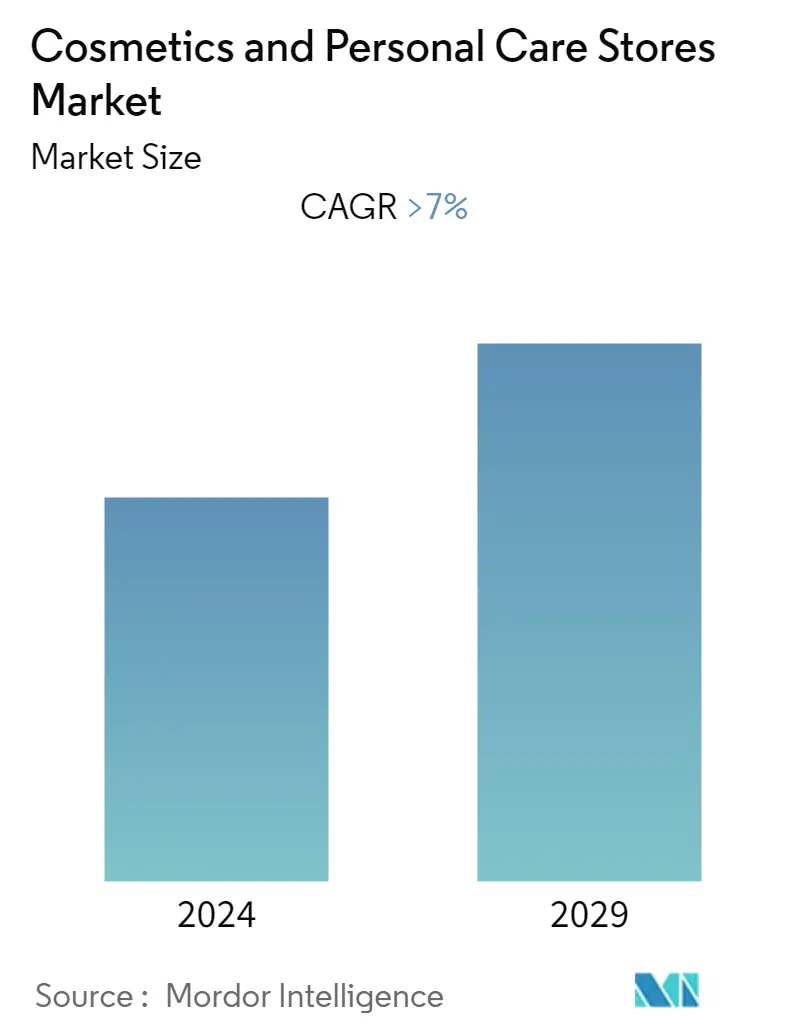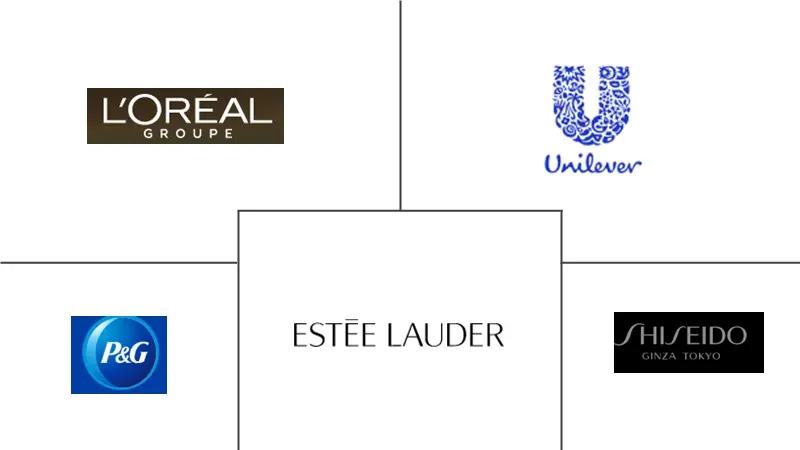Market Size of Cosmetics and Personal Care Stores Industry

| Study Period | 2019 - 2029 |
| Base Year For Estimation | 2023 |
| CAGR (2024 - 2029) | 7.00 % |
| Fastest Growing Market | North America |
| Largest Market | Asia-Pacific |
| Market Concentration | Medium |
Major Players
*Disclaimer: Major Players sorted in no particular order |
Cosmetics & Personal Care Stores Market Analysis
The Cosmetics and Personal Care Stores Market is expected to register a CAGR of greater than 7% during the forecast period(2024-2029).
Direct-to-consumer (DTC) brands and eCommerce had become a way for sellers to sell their products successfully, and cosmetics and personal care stores started using this method of marketing.
With the advent of COVID-19, people's movement decreased due to restrictions on gatherings. As the reduction in people's movements and functions was made and parties were minimized during the COVID-19 period, businesses of cosmetic and personal care products, which are used in functions by people, observed a decline in sales. Other than this, people started shifting towards low maintenance and a natural look, with more attention being paid to health, leading to a negative impact on store sales.
As the global outlook recovered from COVID-19, consumer behavior observed a change. Instead of full makeup, people now prefer swipes of lipstick, eyecare, perfumes, and powder, leading stores to focus on specific varieties of products, which are observing an increase in sales. Consumer preference either towards skincare or makeup will further define cosmetics and personal care store sales globally.
Cosmetics & Personal Care Stores Industry Segmentation
The cosmetics and personal care stores provide customers with cosmetic products that are used for cleaning, improving, or changing the complexion, skin, hair, nails, or teeth. The Cosmetics and Personal Care Stores Market is Segmented By Product Types (Decorative, Skincare, Haircare, Perfume, Oral Care, Bath and Shower), By Distribution Channels (Specialist Retail Stores, Supermarkets/Hypermarkets, Convenience Stores, Pharmacies/Drug Stores), and By Geography (North America, Europe, Asia-Pacific, South America, The Middle East, And Africa). The Report Offers Market Size and Forecasts for Cosmetics and Personal Care Stores in Volume and Value (USD) for All the Above Segments.
| By Product Type | |
| Decorative | |
| Skincare | |
| Haircare | |
| Perfume | |
| Oral-Care | |
| Bath & Shower |
| By Distribution Channel | |
| Specialist Retail Stores | |
| Supermarket/Hypermarket | |
| Convenience Stores | |
| Pharmacies/Drug Stores |
| By Region | |
| North America | |
| Asia-Pacific | |
| South America | |
| Middle East & Africa | |
| Europe |
Cosmetics and Personal Care Stores Market Size Summary
The Cosmetics and Personal Care Stores Market is poised for significant growth, driven by evolving consumer preferences and innovative marketing strategies. The rise of direct-to-consumer brands and eCommerce has transformed how products are sold, with stores increasingly adopting these methods. The COVID-19 pandemic initially led to a decline in sales due to reduced social gatherings and a shift towards minimalistic and natural beauty trends. However, as consumer behavior shifted post-pandemic, there was a resurgence in demand for specific beauty products, such as lip care, eyecare, and fragrances. This shift has prompted stores to focus on a diverse range of products, catering to both skincare and makeup preferences. The market is further influenced by demographic trends, with a significant portion of revenue coming from the female population and a growing interest among middle-aged consumers seeking anti-aging solutions.
The global cosmetics and personal care market is characterized by a strong emphasis on wellness and holistic beauty, with consumers increasingly viewing beauty products as a lifestyle choice. This trend is reflected in the rising demand for natural and organic ingredients, particularly in the luxury skincare segment. Major players like L'Oreal, Unilever, and Estee Lauder continue to expand their global presence through strategic acquisitions and new product launches. The market's growth is supported by a robust consumer base in regions like the United States, where spending on beauty products has seen substantial increases. As the market evolves, stores remain a crucial component in the distribution and marketing of cosmetics and personal care products, adapting to changing consumer needs and preferences.
Cosmetics and Personal Care Stores Market Size - Table of Contents
-
1. MARKET DYNAMICS AND INSIGHTS
-
1.1 Market Overview
-
1.2 Market Drivers
-
1.3 Market Restraints
-
1.4 Industry Value Chain Analysis
-
1.5 Industry Attractiveness - Porter's Five Forces Analysis
-
1.5.1 Bargaining Power of Buyers
-
1.5.2 Bargaining Power of Suppliers
-
1.5.3 Threat of New Entrants
-
1.5.4 Threat of Substitutes
-
1.5.5 Intensity of Competitive Rivalry
-
-
1.6 Insights of Technology Innovations in the Market
-
1.7 Impact of COVID-19 on the Market
-
-
2. MARKET SEGMENTATION
-
2.1 By Product Type
-
2.1.1 Decorative
-
2.1.2 Skincare
-
2.1.3 Haircare
-
2.1.4 Perfume
-
2.1.5 Oral-Care
-
2.1.6 Bath & Shower
-
-
2.2 By Distribution Channel
-
2.2.1 Specialist Retail Stores
-
2.2.2 Supermarket/Hypermarket
-
2.2.3 Convenience Stores
-
2.2.4 Pharmacies/Drug Stores
-
-
2.3 By Region
-
2.3.1 North America
-
2.3.2 Asia-Pacific
-
2.3.3 South America
-
2.3.4 Middle East & Africa
-
2.3.5 Europe
-
-
Cosmetics and Personal Care Stores Market Size FAQs
What is the current Cosmetics and Personal Care Stores Market size?
The Cosmetics and Personal Care Stores Market is projected to register a CAGR of greater than 7% during the forecast period (2024-2029)
Who are the key players in Cosmetics and Personal Care Stores Market?
Loreal, Unilever, P&G, Estee Lauder and Shiseido are the major companies operating in the Cosmetics and Personal Care Stores Market.

